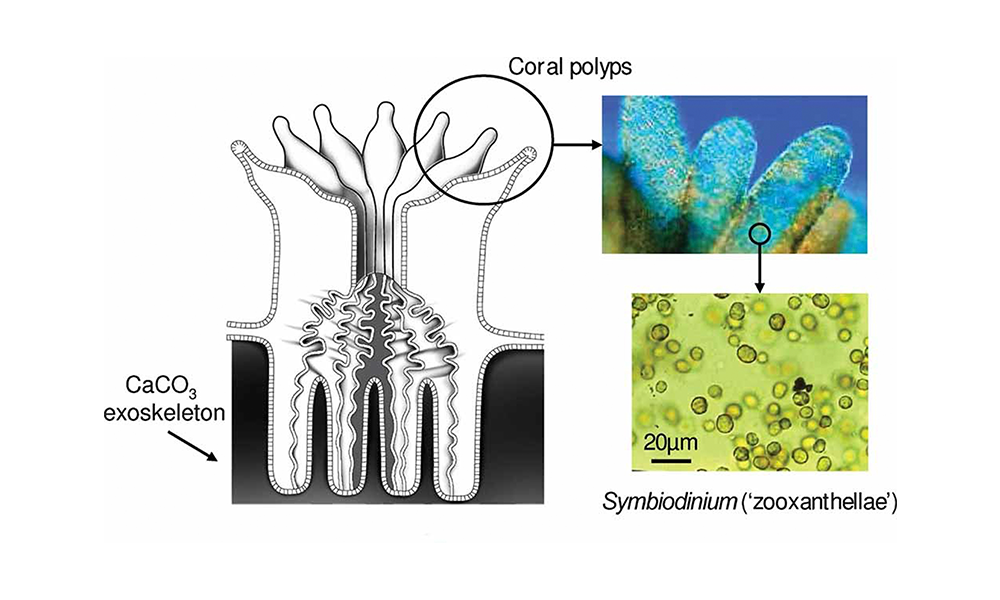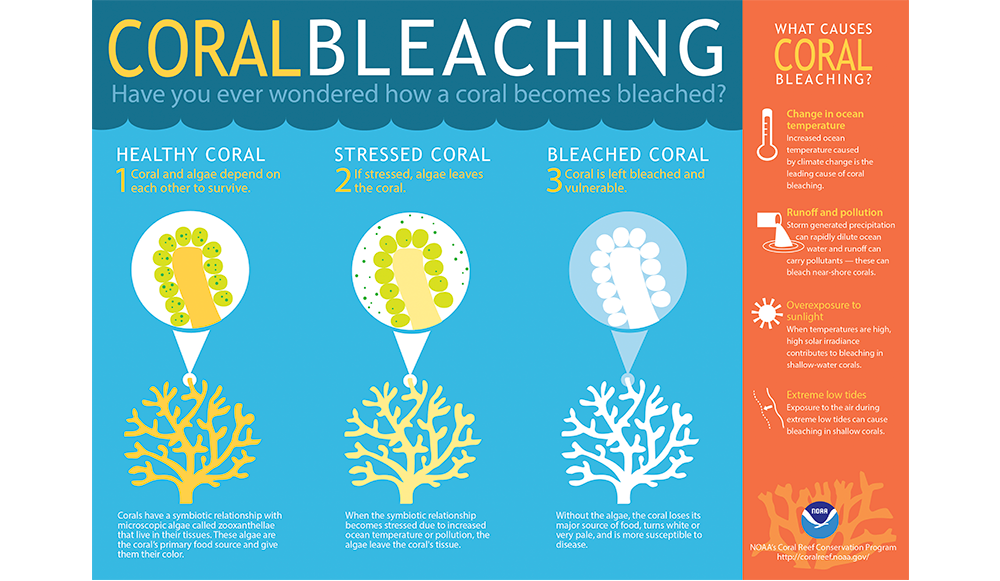Concept¶
Coral reefs¶
Beneath the ocean surface, an expansive network of dynamic skeletal-like invertebrates harbours at least 25 per cent of all known marine species. Both hard and soft corals provide the basis for functioning coral reefs, which are some of the planet's most biologically diverse and valuable ecosystems. They provide important cultural, economic, recreational and social benefits to hundreds of millions of people. They buffer shorelines against damage from storms and provide a source of medicine.
Benefits of coral reef ecosystems¶
Coral reefs protect coastlines from storms and erosion, provide jobs for local communities, and offer opportunities for recreation. They are also are a source of food and new medicines. Over half a billion people depend on reefs for food, income, and protection. Fishing, diving, and snorkeling on and near reefs add hundreds of millions of dollars to local businesses. The net economic value of the world's coral reefs is estimated to be nearly tens of billions offsite link of U.S. dollars per year. These ecosystems are culturally important to indigenous people around the world.
Corals and MicroAlgae - A symbiotic relationship¶
Most reef-building corals contain photosynthetic algae, called zooxanthellae, that live in their tissues. The corals and algae have a mutualistic relationship. The coral provides the algae with a protected environment and compounds they need for photosynthesis. In return, the algae produce oxygen and help the coral to remove wastes. Most importantly, zooxanthellae supply the coral with glucose, glycerol, and amino acids, which are the products of photosynthesis. The coral uses these products to make proteins, fats, and carbohydrates, and produce calcium carbonate. The relationship between the algae and coral polyp facilitates a tight recycling of nutrients in nutrient-poor tropical waters. In fact, as much as 90 percent of the organic material photosynthetically produced by the zooxanthellae is transferred to the host coral tissue. This is the driving force behind the growth and productivity of coral reefs.

In addition to providing corals with essential nutrients, zooxanthellae are responsible for the unique and beautiful colors of many stony corals. Sometimes when corals become physically stressed, the polyps expel their algal cells and the colony takes on a stark white appearance. This is commonly described as coral bleaching. If the polyps go for too long without zooxanthellae, coral bleaching can result in the coral's death.
Because of their intimate relationship with zooxanthellae, reef-building corals respond to the environment like plants. Reef corals require clear water so that sunlight can reach their algal cells for photosynthesis. For this reason they are generally found only in waters with small amounts of suspended material, or water of low turbidity and low productivity. This leads to an interesting paradox—coral reefs require clear, nutrient-poor water, but they are among the most productive and diverse marine environments.
Deep-sea corals live in much deeper or colder oceanic waters and lack zooxanthellae. Unlike their shallow water relatives, which rely heavily on photosynthesis to produce food, deep sea corals take in plankton and organic matter for much of their energy needs.
Corals and MacroAlgae¶
Macroalgal species are divided among three large groups that are named according to the colour of their dominant photosynthetic and accessory pigments: red (Rhodophyta), green (Chlorophyta) and brown (Phaephyta).

Red algae are the largest and most diverse group, and are extremely important reef-building organisms. Green algae contain chlorophyll and often favour stressful environments where nutrients are high and herbivory is low. Others are calcified and contribute heavily to the sandy sediments of reef areas. Brown algae range in colour from beige to almost black and are more abundant in temperate seas. Algae can also display a variety of forms including: fleshy macroaglae (which generally has a canopy height of over 1cm), turfing (which form a mat less than 1 cm high on the substratum), and crustose coralline algae (which form flat plates on the substratum and may cement coral fragments together).
Fleshy macroalgae are larger, erect algae which quite often possess chemical or structural deterrents to protect against herbivory. An overabundance of macroalgae can also impede coral recruitment and reduce overall coral survival. Macroalgae have important ecological and economic roles on coral reefs. They are primary producers that form the basis of many marine food chains and provide habitat and refuge for a range of organisms. They are also commercially important for food (e.g. sushi), science (e.g. agar culture mediums) and for their compounds (e.g alginate - used in a variety of products from toothpaste to ice cream).
Macroalgae are also often used as indicators of water quality and reef health. Many species of macroalgae have the ability to assimilate the surrounding water and store it over a short period. These species can therefore be used to monitor changes in the nutrient concentration in the water, particularly nitrogen. In addition, the abundance of macroalgae responds to changes in nutrient concentrations, with increased abundances often indicating elevated levels of nutrients.
Macroalgae can also be major contributors to reef degradation via ecological 'phase-shifts' whereby the dominant taxa on the coral reef shifts from hard, reef-building corals to fleshy macroalgae. The phase shift is generally initiated by a disturbance such as coral bleaching, outbreaks of the coral-eating crown-of-thorns starfish (COTS), coral disease or storm damage. In a healthy system, corals would be able to slowly recover and recolonise the disturbed area. If, however, the number of herbivores in the area has been reduced by overfishing, or the area is affected by elevated levels of nutrients or sediment, a permanent shift to an algal dominated system and an overall reduction in the aesthetic value of coral reefs might occur, which could have flow-on economic for tourism in highly visited areas.

Coral Bleaching - A threat¶

Unfortunately, coral reef ecosystems are severely threatened. Some threats are natural, such as diseases, predators, and storms. Other threats are caused by people, including pollution, sedimentation, unsustainable fishing practices, and climate change, which is raising ocean temperatures and causing ocean acidification. Many of these threats can stress corals, leading to coral bleaching and possible death, while others cause physical damage to these delicate ecosystems. During the 2014-2017 coral bleaching event, unusually warm waters (partially associated with a strong El Niño) affected 70% of coral reef ecosystems worldwide. Some areas were hit particularly hard, like the Great Barrier Reef in Australia, where hundreds of miles of coral were bleached.

Corals are able to recover from bleaching events if conditions improve before they die, though it can take many years for the ecosystems to fully heal. Scientists are also testing new ways to help coral reef ecosystems, such as growing coral in a nursery and then transplanting it to damaged areas.
Cause of coral bleaching¶
 - Vogue India
- Vogue India
The material choice alone can account up to 95% of a product's environmental and social footprint (The sustainability angle,2020).Efforts of major environmental corporations around the world are especially focused on combatting climate change, and rising sea temperatures. Few corporations proposed solutions towards the textile industry-the second largest contributor of water pollution according to UNEP.
According to data from World Wildlife Fund, one of the most widely used textiles-cotton accounts for 18 per cent of pesticides worldwide and is toxic to marine species. Polyester (nondegradable) is one of the leading causes of microfibre in ocean. Polyester, nylon, acrylic, and other synthetic fibers (all of which are forms of plastic) are now about 60 percent of the material that makes up our clothes worldwide. Synthetic plastic fibers are cheap and extremely versatile, providing for stretch and breathability in athleisure, and warmth and sturdiness in winter clothes.
These fibers contribute to ocean plastic pollution in a subtle but pervasive way: The fabrics they make along with synthetic-natural blends leach into the environment just by being washed. Estimates vary, but it's possible that a single load of laundry could release hundreds of thousands of fibers from our clothes into the water supply.
- Similarly, the microfibres are finding their way into the oceans, where fashion materials such as polyester are non-biodegradable and accumulate to fishes when planktons consume it, which means less species which consume the fleshy macro algae (which are increasing due to increased nutrients from fertilizers that runs off the land) which eventually leads to coral bleaching.

China is a country where 60 per cent of water sources are considered unfit for human contact. 10 per cent of all industrial wastewater emissions come directly from the fashion industry with 72 per cent of the toxic chemicals in the water coming from textile dyeing, according to The Guardian.

We can tell what colour will be in fashion next season based on the colour of the rivers, Synthetic Textiles accounts for 35% of the microplastics in water, which emphasizes that the textile industry is the second largest contributor to water pollution.
- All the waste and pollution released by washing/discarding/incinerating clothes contributes to rising ocean temperatures, that leads to expulsion of algae from coral polyps, which in turn leads to coral bleaching.
Fashion needs to be beautiful, safe, and fair for everyone. Thus, a new approach is needed. This project focuses on combining designing with new technologies, Fabrication of new lab-made materials - the slowness of lab-made and crafted materials offers an alternative to fast fashion and inspires for a mind shift.
The idea is to merge biotech and fashion, demonstrating innovation in materials, technologies, and digital fabrication and mutating the concept of wearables to a human-microorganism symbiosis. This project re-imagines how clothes are made by creating fully fashioned, seamless, fabricated garments engineered in lab using technologies rather than through a cut & sew manufacturing process, resulting in reduced material waste, resource usage, Bio-degradable materials, shortened supply chains and ultimately tackling sustainability.
WHO WHAT WHY WHEN